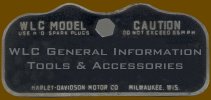

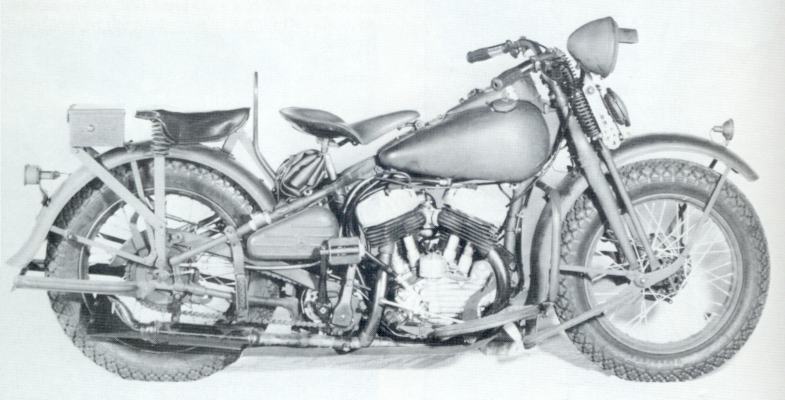
Harley-Davidson Military Model 42WLC
Prior to WW2, the
Canadian Army, known as the Canadian National Defense Forces, purchased and used
Norton, BSA and Indian motorcycles. Their preference was to use the same
motorcycles as the British, their Commonwealth partner.
But as war progressed, England did not have enough motorcyles to meet Canada's
needs and they had to turn to other manufacturers. After France capitulated, the
British took over an Indian contract for the French Army and supplied several
Indian Chief models to Canada.
Canada ordered more Chiefs, along with the 640 Scout Model straight from Indian,
as they were pleased with the supplied bikes.
However when Indian started to have trouble meeting spare parts orders and
several problems arose with the bikes themselves, Canada started looking for
another motorcycle supplier which they found in Harley-Davidson. As with Indian,
Canada ordered both 45ci Solo models and Big Twins from the Milwaukee factory.
These would be known as the WLC and ELC Models respectively.
WLC Production
WLCs were made from late 1941 through 1944 and were known as the Model 42WLC and Model 43WLC. The 43WLC was made in a 'Domestic' model for use in Canada and an 'Export' version for use overseas. Contrary to the WLA, the WLC Models had two different style Engine Numbers, either 42WLCXXXX or 43WLCXXXX.
The WLC Model, although very similar to the US Army WLA, differs in many details from its American counterpart. Front and rear wheels are interchangable, front brake drum is the 'Big Twin' style, lighting equipment is quite different, throttle is on the left handlebar with ignition timing on the right, oil and gas lines are rubber, an auxiliary clutch hand lever is provided on the handlebars, later 43WLC have green plastic handlebar grips, a ride-control is provided on the front fork with an extra stand on the front wheel, the rear stand has additional 'Sand Pads', etc....
WLCs
were not equipped with a Submachinegun bracket
and Ammo box at the factory!
WLCs were mainly used by the Canadian (and Commonwealth) Armies,
thus a correctly restored WLC should not have US Army markings* , just as a
restored WLA should not have a WLC numbered engine.
(*except
for very few exceptions used by the US Army as shown on the next page)
Below is a chart showing which engine numbers were used in which types and what timeframe they were produced. The chart also shows the Canadian National Defense Forces Registration Numbers which were assigned to each bike. More information about these numbers is found below. The chart was compiled from information in Bruce Palmer's books, and a few numbers falling outside of this list have been observed. There may be a few exceptions to the 42WLC Engine Numbers, but to date there are no records to verify these....
| WLC | Date of Manufacture | Engine Crankcase Numbers | CNDF Registration Numbers |
| Type 42WLC |
August 1941-November 1941 January-May 1942 & August 1942 |
42WLC1000-42WLC4800 42WLC10000-42WLC25000 |
41-1-2200 -
41-1-6200 42-1-100 - 42-1-8000 * |
| Type 43WLC | October 1942-February 1944 | 43WLC1000-43WLC9134 | CC-42xxxxx (see below) |
* From photographic evidence it seems some 42WLC Models were registered with the later 43WLC style numbers ( CC42xxxxx )
What does WLC stand for?......
Throughout its
history, Harley-Davidson has been using a combination of letters to designate
the different models it manufactures. The Model WLC
is no exception.
Since the
WLC
was based on the
WLA
which was already being delivered to the US Army, Harley-Davidson only changed
the last letter to indicate a variation on an existing model.
The 'W'
shows that the motorcycle is equipped with a 45 cubic inch, side valve engine, introduced in 1937
and first used on the Model W bikes.
The letter 'L'
stands for High Compression. It is however not indicative of compression on
current models.
And finally 'C'
indicates a model developed for the Canadian National Defense Forces.
How to recognise the different types.....
On original WW2 images, it's impossible to make out the engine number but typical features of each type can help in properly distinguishing a certain type of WLC from another. Using Bruce Palmer's books, a list was compiled to aid in identification and this chart should enable any WLC buff to distinguish different types....
| Type WLC | Rapid Identification Distinguishing Features |
| 42WLC | High Mounted Headlight, Large Marker and Rear Lights, Auxiliary Tool Box on Front Fender (sometimes on Rear Fender), Low (British Style) Tandem Seat, Black-Out Equipment in Box, Stop Lamp Cut-Off Switch on right rear forks, Round Air Cleaner, Bicycle Type Starter Pedal (up to 42WLC19000), Air Cleaner Guard only |
| 43WLC 'Domestic' | Low Mounted Headlight, CMP Style Marker and Rear Lights, High Tandem Seat with integrated Saddle Bag Carrier, Stop Lamp Cut-Off Switch on right rear forks, Rectangular Air Cleaner, Steel Spool Type Starter Pedal, Air Cleaner Guard only, OD Painted Crankcase and Transmission and Black Painted Cylinder Heads (From 43WLC3072) |
| 43WLC 'Export' | Low Mounted Headlight with Black-Out Shroud, CMP Marker and Rear Lights, Luggage Rack with Saddle Bag Carrier, Rectangular Air Cleaner, Steel Spool Type Starter Pedal, Complete Rear Safety Guard, OD Painted Crankcase and Transmission and Black Painted Cylinder Heads (From 43WLC3072) |
All 42WLC and the 'Domestic'
43WLC were delivered with a tandem seat above the rear fender, but the 'Export'
version of the 43WLC was supplied with a luggage rack identical to the WLA, with
attached leather Saddle Bags.
Even so, most 43WLC were fitted with passenger foot pegs.
The passenger seat on the 42WLC was similar to the British seats, but on the
43WLC it sat higher above the rear fender.
In July 1943, the Canadian MT
User Committee recommended that windscreens, leg guards and pillion seats be
removed from Harley-Davidsons. It was felt by the Committee that English weather
did not at any time call for the need for these articles. In fact there had been
several complaints raised about the increase in injuries caused by striking the
windscreen. Also, in cases where the rider lost control of the machine, the hand
grip was accused of aggravating the injuries. As a result of these
recommendations the windscreens were discontinued from production immediately (7
July 1943), the pillion seat and hand grip as of 21 July 1943, and the leg
shields at the end of July, concurrent with the end of the 9th Canadian order.
However even after this date, 43WLC are often seen fitted with windshields.....
(Official HD Images)
42WLC left and
'Domestic' 43WLC right
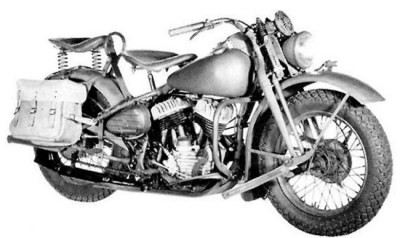
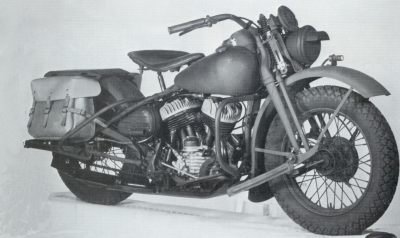
(Official HD Images)
'Domestic' Model 43WLC left and
'Export' Model 43WLC right
The 42WLC was issued with an additional toolbox on the front fender, which was sometimes replaced by a mounting of this same box above the rear fender behind the passenger seat (see photo on top of page).
The 42WLC was equipped with the standard Guide Cycle Ray glass lens headlight, mounted in the high position above the horn, and unshielded front marker and rear lights. The bikes that were shipped overseas were supplied with a lens shroud on the headlight and shielded marker lights front and rear. These 42WLC were issued with a small steel box containing this shroud and other shields. The box was marked "BLACK OUT EQUIPMENT for Harley-Davidson '45' cu. in. WLC model".
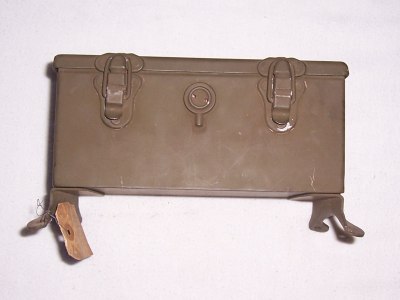
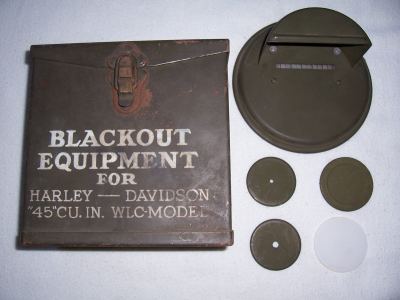
Tool Box & Black-Out Equipment
from the Prem Zizka Collection.
Left is the Auxiliary Tool Box (Part N° 3452-41A) mounted on the front fender
of the 42WLC.
The Black-Out
Equipment Box for the 42WLC, shown on the right, held shrouds for the headlight,
front marker and rear lights.
It was issued with bikes that were shipped overseas.
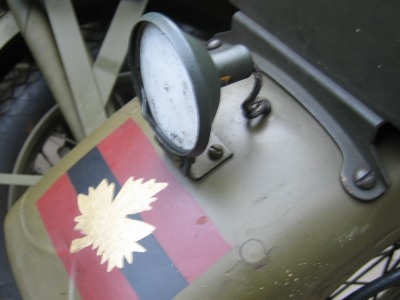
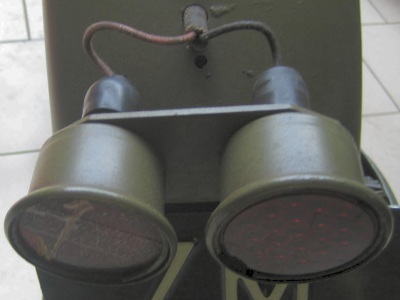
Photos from David Mossou
The larger
front marker and rear lights on the 42WLC.
The insignia painted on the front fender is that of the Canadian 1st Army which
took part in the liberation of France,
Belgium and Holland in 1944-1945.
The 43WLC was manufactured with either plain or shrouded headlight, mounted below the horn, and the smaller Canadian Military Pattern (CMP) tube style marker and rear lights.
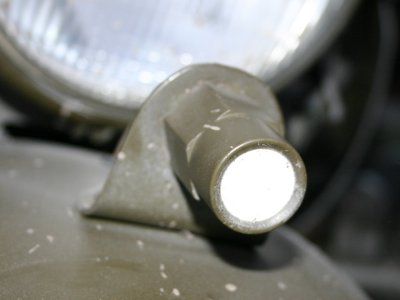
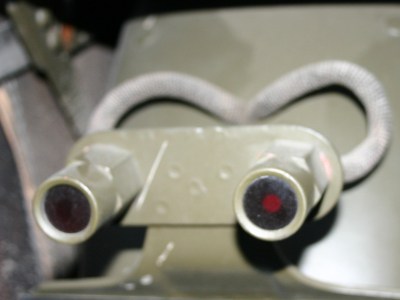
Standard CMP front marker and rear lights on the 43WLC.
The WLC was equipped with an Auxiliary
Cut-Off Switch on the right rear forks just above the toolbox, which allowed
switching off the STOP light. It was later moved forward on the frame underneath
the saddle.
The
switch is marked: 'STOP LIGHT ISOLATION SWITCH'.
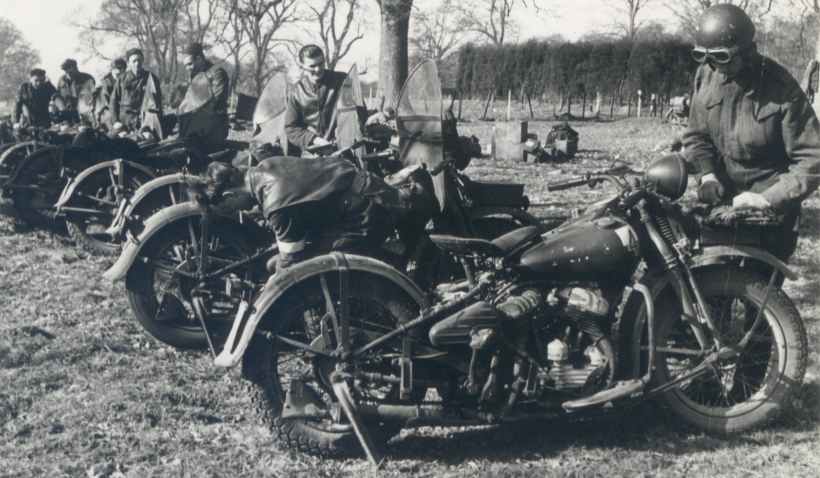
Photo from the Webmaster's Collection
Canadian
Dispatch Riders with their 42WLCs during exercise Spartan in England, March
12th, 1943.
The Auxiliary
Cut-Off Switch is clearly visible on the first two bikes and on the detailed
images below.
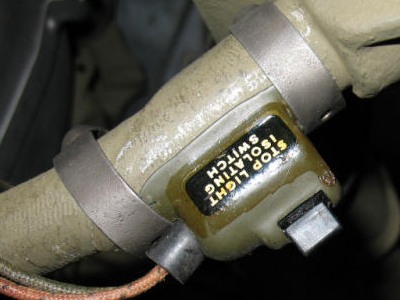
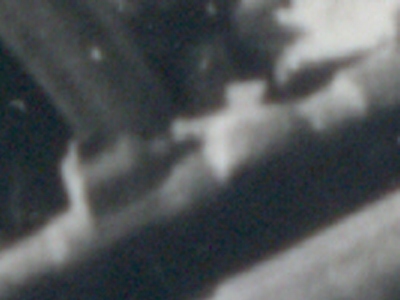
Photo left courtesy of John
G, fellow 42WLA
Yahoo Group Member and detail of the above WW2 picture
The picture
on the left shows an Auxiliary
Cut-Off Stop Light Switch mounted on the rear
forks of a restored bike.
It has been moved forward underneath the saddle following
'Harley-Davidson Motorcycle Modification Instruction
N°4'.
WLC Engine Numbers and details
WLCs
did not receive a frame tag or
frame number during production and were identified by the engine number, embossed on the left side
of the crankcase in the following fashion '42WLCXXXXX'.
This was the Vehicle Identification Number (VIN).
Furthermore all Harley-Davidson engine crankcases
were numbered during their production on the lower front side of both halves by
the year of manufacture followed by the sequence in which the crankcases were
mated together
(ie 42-12345 = the 12345th engine assembled in 1942).
The WLC motors were not all made in succession and from approximately 43WLC6000,
1944 dated crankcases were used.
Since the WLC was identified by its engine number only, this made control and accounting of the WLC Motorcycles by the Army very difficult, especially after engine replacement. In 1944 the Canadian Electrical and Mechanical Engineers (RCEME) issued 'Harley-Davidson Motorcycle Modification Instruction N°1' ordering the RCEME workshops to stamp the WLC Serial Number on the frame just in front of the saddle post at the time of overhaul. More about this Modification Instruction is found at the bottom of this page.
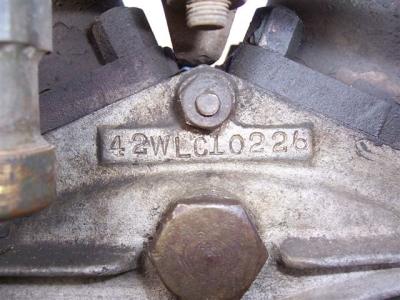
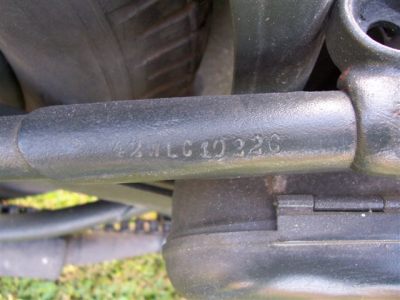
Close-up of
Engine Number 42WLC10226 on Prem Zizka's WLC.
The number has been stamped on top of
the right rear forks just above the toolbox
instead of to the front of the
saddle post following the Modification
Instruction N°1.
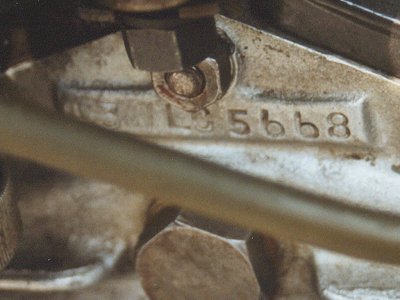
Typical 43WLC Numbered Engine Crankcase of Joeri Quintyn's 43WLC5668
Most differences between the WLA and WLC are obvious, but some of them, mainly on the engine, are barely noticable. These are visible on the photos shown below.
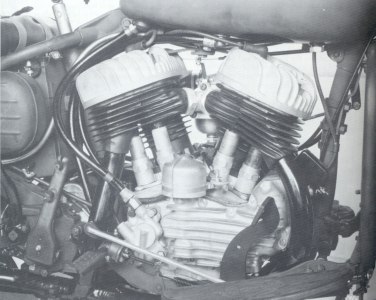
(Left: Official HD Image -
Right: Photo from Darcy Miller thru Prem Zizka)
This close-up of a 42WLC pilot model engine on the left shows the changes requested by the
Canadian Army. Note the neoprene covered fabric oil lines, passenger foot peg,
auxiliary hand clutch cable on the clutch release lever ands the Rajah spark
plug rubber caps. The lap apron roll is fitted to the rear forks above the
battery box. Note the cadmium plated and parkerised finish of the different
parts.
The photo on the right shows the same details on an unrestored 43WLC; note the
OD-painted Engine Crankcase and Black Cylinder Heads,
and the OD-painted Transmission which appeared from 43WLC3072 up....
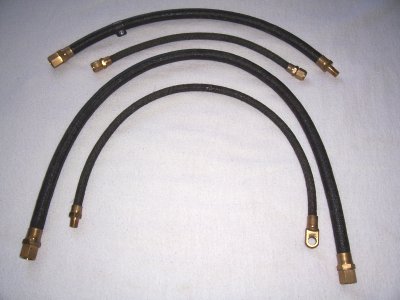
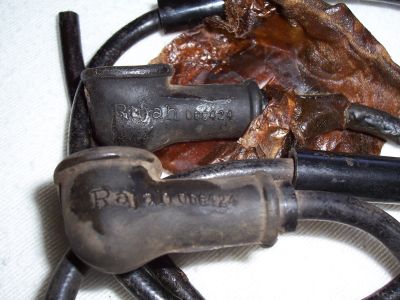
Oil Lines and Spark Plug Caps from the Prem Zizka Collection.
Above left is
a set of Neoprene covered oil and gas lines, typical for
the WLC.
Right an unissued set of Rajah Spark Plug Rubber Caps N° 43-41. They are marked
'RAJAH 066424' on one side,
and 'NIPPLE' and 'BLOOMFIELD N.J. USA.' on the reverse.
Paint, Army Registration Numbers & Markings
WLC motorcycles were
delivered in exactly the same color as the US Army WLA, ie US Army QM Spec ES-N°
474 (enamel, synthetic, olive drab, lusterless flat). They were not to be
repainted in
either Canadian or British colors until the condition of the vehicle made it
necessary, most likely during a complete
workshop overhaul or rebuild near the end of the war or even after WW2.
In 1944 the
British Army even adopted a paint color similar to US olive drab to match the
color of American made lend-lease vehicles, a practice described in
Army Council Instructions (A.C.I.)
533 on Camouflage of War Equipment, dated April 12th, 1944.
It was not common practice to apply a
camouflage pattern to motorcycles contrary to larger Commonwealth
vehicles.
Click
Here to read more
about WW2 British Army vehicle colors and camouflage.
Upon delivery to the Canadian Forces, each WLC received a Canadian National Defense Registration Number, which was painted on both sides of the tanks or somewhere on the fenders. The style of these numbers changed during the war.
The earlier numbers followed a simple pattern; the first two numbers represented the calendar year, followed by a number '1', and the sequential number of actual registration (starting from 100). These numbers were not only issued for motorcycles but randomly for all Canadian Army vehicles. As an example; WLC 42-1-5561 was the 5462nd vehicle issued to the Canadian Forces in 1942.
At some point in 1942
after the Canadian Military moved its forces over to England and became part of
the British Commonwealth Military Forces, the British War Office allocated the
Canadian Army census (vehicle) numbers that started at 4200000 matching the British style of vehicle
numbers.
British census numbers were composed of a letter indicating the type of vehicle followed by a registration
number (ie M1234567 was a Motor car numbered 1234567). The letter assigned to motorcycles of the Commonwealth
Armies was the letter 'C'.
The Canadian Forces eventually fielded 92000 motor vehicles which were numbered
in the 4200001 to 4292000 range with no particular number blocks being assigned
to particular vehicle types.
In order to make it clear it was a Canadian Defense Forces vehicle a 'C'
preceded the census number of the vehicle (ie Motorcycle CC-4213708 or Jeep
CM4230213).
The few vehicles with numbers that deviate from this formula are the unexplained
exception to the rule...
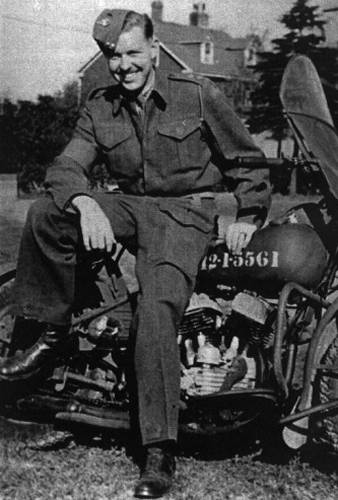
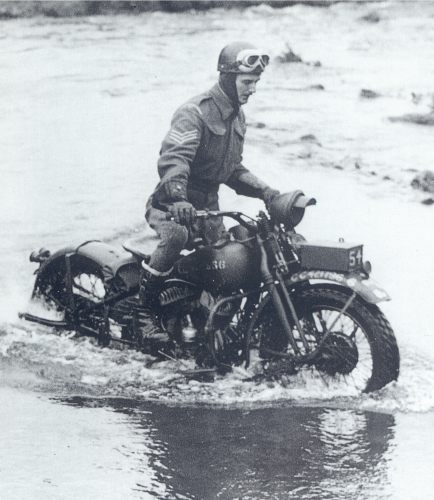
Left: A 42WLC bearing SerNr 42-1-5561. Seated on it
is Lt Stevens while serving in Newfoundland with the Lincoln & Welland
Regiment, circa 1942. According to the Nr this would be the 4562nd vehicle
issued to the Canadian Army in 1942.
(Picture from
Colin Stevens)
Right: The later Commonwealth style Vehicle Census Number CC4217966 has been
painted on the front fender of this 42WLC Model. It is not clear on the
original image if the number on the oil tank is identical to the fender number.....
The meaning of the other markings remain unclear.
(Photo: National Motor Museum)
Unit identification markings followed the typical British style showing the larger unit insignia (Army, Corps or Divisional sign) painted in a rectangle above a Tactical Sign representing the smaller unit. Other units, mainly Royal Air Force units carried a numerical code...
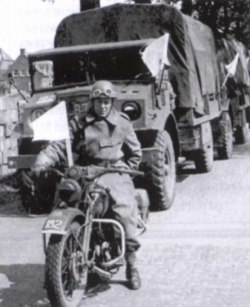
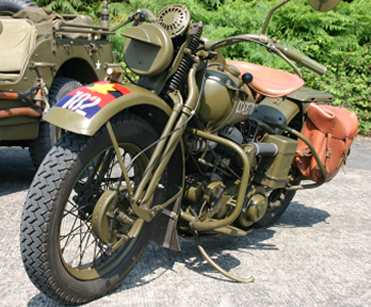
This Export 43WLC heads a CMP Truck column carrying
food to the Dutch population in April 1945. The rider has been identified as
Corporal William James (Jamie) Shipton from Kingston,Ontario of the First
Division,Royal Canadian Army Service Corp. The markings on these vehicles identify
the unit as 3rd Medium Regt RCA, attached to the 1st Canadian Army in Holland in
1945.
(Picture from Steve
GUTHRIE)
Inspired by the wartime image, Joeri Quintyn marked his
43WLC5668 accordingly just prior to the Belgian Wings&Wheels Show on August 8th
2004. The white line under the insignia was still missing.
On 43WLC equipped with a Radio-Suppression electrical system, a letter 'S' is factory-applied to both sides of the dash cover. Bruce Palmer states this marking was red, but just as it has been proven to be blue-drab on the WLA, one can expect it to be of the same color on the WLC.
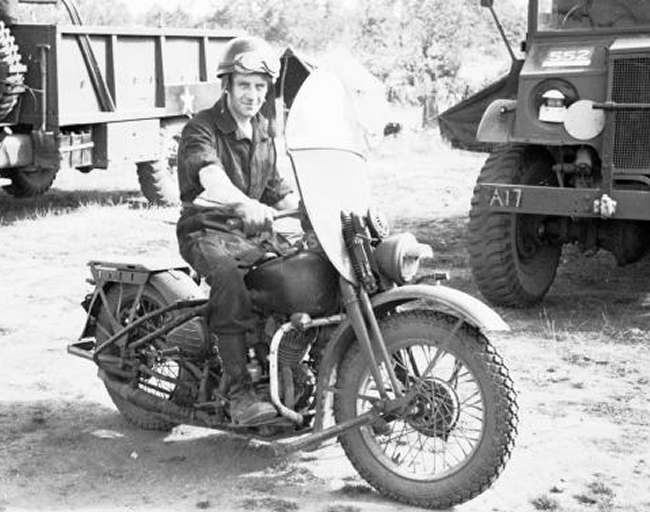
Photo from
www.noviomagus.nl via James Thompson
The 'S' marking on
the side of the dash cover is clearly visible on this 43WLC of the No. 64 Army
Transport Company, Royal Canadian Army Service Corps (R.C.A.S.C) attached
to the Canadian 1st Army, stationed in Nijmegen, Holland in early 1945.
Although hard to say, it seems the color is blue drab rather than red.
Note the US Black Out Marker light mounted on the front safety bar.
Click Here for more information about color and markings of Canadian Army vehicles during WW2!
Standard WLC Tires in WW2
WLC Motorcycles were fitted with Firestone Sportsman Type 4.00-18 tires, recognisable by the distinctive cross-lug pattern tread; but just as with the WLA, other brands and types may have been used. These original tires are made of very hard rubber and are not safe to ride! Coker Tire produces acceptable replacement tires with similar patterns for restorations.
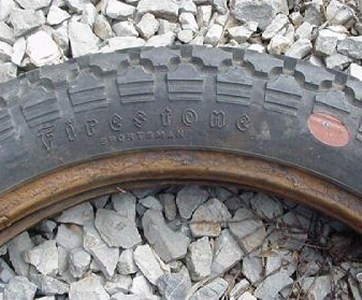
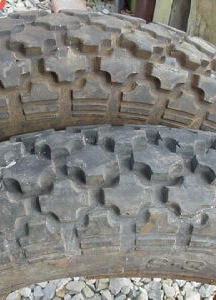
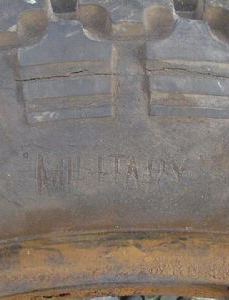
Tires from a Private Collection
A clear view of the
Firestone Sportsman tires and their distinctive tread pattern
Note the markings
'S-3' and 'MILITARY' and the red dot indicating synthetic 'war-production'
rubber.
|
|
'1944 Signals Training' 2nd Lt Edward
"Eddie" Bobyn of the Royal
Canadian Corps of Signals
sits on a 42WLC at the Vimy
Barracks of the Kingston Ontario Army Base during training in the summer
of 1944. Close study of the pictures shows the holes in the front fender to mount the tool box. The fender marker light has been removed. The Firestone Sportsman tire pattern is perfectly visible in the picture. |
Manuals, Tools, Spare Parts & Equipment
Upon delivery, each WLC was equipped with a Windshield, a Lap Apron and two leather Saddle Bags. A Tool Roll, Spare Parts Set and various Manuals were provided with each motorcycle.
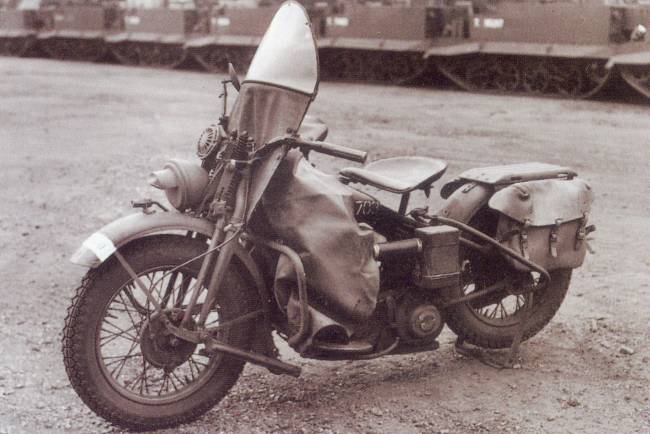
Photo: Public Archives of
Canada
On this beautiful image of
a 43WLC 'Export' Model in front of rows of Ford T16 Carriers in an Army Depot
somewhere in England before the Normandy invasion; most of the distinguishing
features of the WLC are clearly visible. Of special interest here is the lap
apron attached to the handlebars and the way the windshield apron is attached
behind the handlebars rather than in front. Also note the flat 'sand pads'
attached to the rear stand. The markings on the front fender are not clear and
the Vehicle Serial Number on the tank is partly obscured by the apron. A rear
view mirror, not normally fitted to the WLC has been added to the handlebars.
Tires seem the Firestone All Non Skid (ANS) type.
Manuals
Original Data Plates from Prem
Zizka
(Left) and Frank Berg (Right)
As with the WLA,
the publications applying to the WLC are marked on the motorcycle's data plate,
attached to the upper frame between the dash cover and saddle.
Above left is the Data Plate
from a 42WLC which lists the HD-WLC-03 Parts List and M/C-HD1 Maintenance Manual. The
43WLC Data Plate on the right, lists the HD-WLC-04 Parts List
and other types of oil.
A
selection of WW2 printed manuals is shown below. Note all were printed in the
USA.
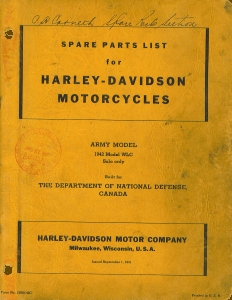
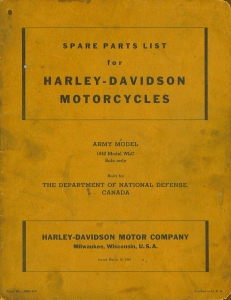
Shown above are the
covers of original Parts Lists for the WLC.
FORM N° 13850-42C, dated September 1st, 1941 (left) and March 15th, 1942
(middle)
FORM N° 13850-43C, dated July 1st, 1943 (right)
Note that the 1941 and 1942 editions only list parts of the 42WLC while the 1943
edition has parts for both the 42WLC and 43WLC models.
Below are the Operator's Manuals provided with the bikes. The 1942 edition left,
1943 middle and the general MC-HD1, from the Data Plate on the right.
Manuals shown are all from the Prem Zizka Collection.
Tools & Spare Parts
A set of tools
and spare parts were issued with each WLC. These kits allowed small repairs in
the field.
Both the 42WLC and 43WLC were provided with Tool Set 11800-41, although the
drawings in the manuals show some subtle differences.
42WLC Tool
Kit as shown in the manual. Parts Numbers are the HD Company numbers
Mouse Over image for a
1942 WLC Tool Kit
from the Prem Zizka
Collection
43WLC Tool Kit as shown in the manual. Note the Saddle Bags with extra internal pocket (see below)
Windshield & Lap Apron
Identical to the WLAs windshield, the
apron provided with the WLC was made out of
leatherette. Two different types have been observed, one with a narrow slot, and
one with the larger rounded slot. This second type was superceded by a canvas
apron late in 1943 at approx 43WLC3072. Although it is not clear why these were made
in two different types, the narrow slotted one was probably issued with the
42WLC which had the high mounted headlight, while the 43WLC with low headlight
and wider headlight and horn bracket was provided with the second pattern apron.
A large lap apron was issued with each WLC and protected the rider's legs
and lower body in bad weather. It was rolled and stowed above the battery box
when not in use. This fabric apron was considered more adequate than the WLAs metal legshields which were cumbersome to carry when not in use and therefore
often discarded in the field.
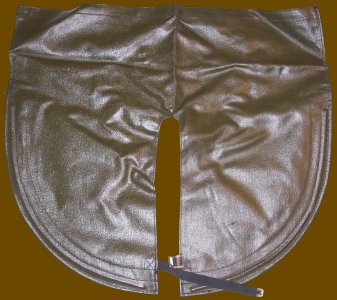
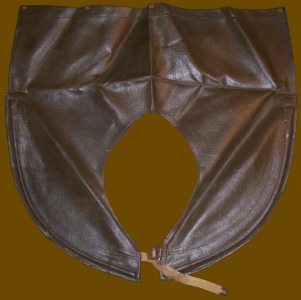
Early narrow slotted
Leatherette Apron left with later rounded Leatherette Apron right.
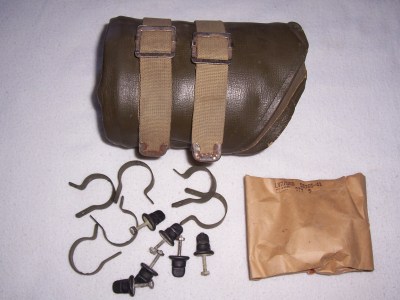
Aprons from the Prem Zizka Collection.
The Lap Apron
was attached to the handlebars and frame with provided studs and clips.
It was rolled up with two straps when not in use.
|
The photo right shows an unidentified Dispatch-Rider of the 2nd Canadian Corp's HQ with two WLC Motorcycles during exercise Spartan in England, March 12th, 1943. The bikes are clearly 42WLC Models, evidenced by the bicycle style starter pedal. Of
special notice here is the first pattern narrow slotted leatherette apron
on the windshield of the bike on the left and the lap apron on the bike on
the right. Note
the Canadian Army Registration Number on the tank (CC-4222117), partly
worn off from use.
A tire pump is attached to the front safety bar and saddles have been
mounted in the high and low position with the provided washers above or
under the seat T-bar. |
|
Saddlebags
The 43WLC was supplied with a set of two saddlebags (Part Number 11786-43). These bags seem identical to the ones issued with the WLA (Part Number 11786-XM) but are equipped with a large leather pocket sewn inside the bag.
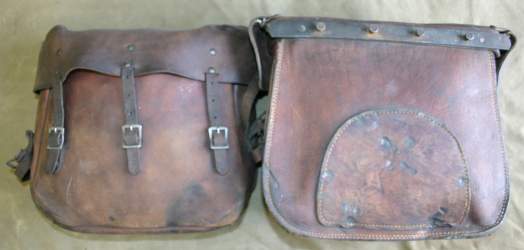
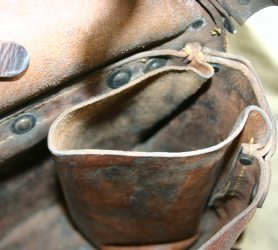
Saddle Bags from the
Webmaster's Collection
Harley-Davidson WLC Motorcycle Modification Instructions
As war progressed; the use of the WLC Motorcycle was evaluated by the Canadian Defense Forces and a number of modifications were ordered to be made to the bikes by the RCEME workshops upon overhaul or during Maintenance. These 'Harley-Davidson Motorcycle Modification Instructions' are shown below, click on the link to view them....
|
'Modification
Instruction N°1': Stamping
of Engine Serial Number on Frame All Instructions shown, courtesy of John G, except N°7, courtesy Jerome H! |
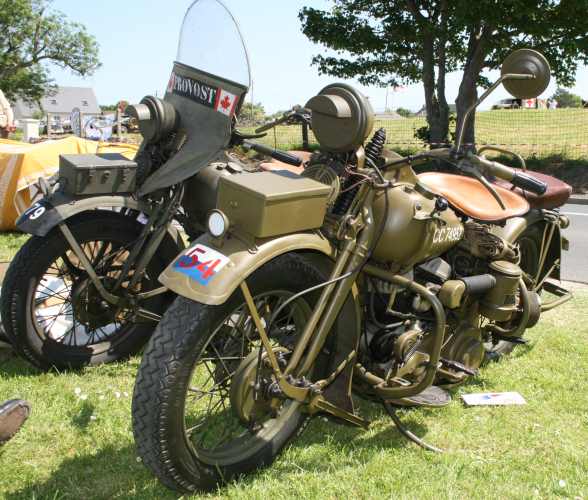
Two WLC in Normandy
for the D-Day Commemorations in June 2009
The bike on the right is 42WLC1941, and both were nicely restored.
While photos of WLAs in action
during WW2 are rather common,
those showing the use of WLC motorcycles are quite scarce.
A selection is shown on the next page.